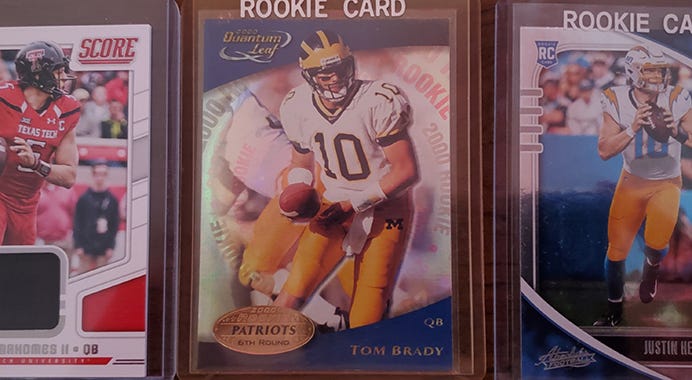Fanatics' Approach Should Include All Collector Types
With Fanatics getting exclusive licenses for MLB, NBA and likely NFL, the company needs to keep both kids and serious collectors in mind.
Last week, I wrote about Fanatics landing the exclusive licenses from Major League Baseball and the MLB Players Association to produce baseball cards.
Since that time, it's become official that Fanatics will get those licenses from NBA and the NBA Players Association, plus the license from the NFL Players Association (the NFL hasn't yet agreed).
What happens next remains to be seen, but one thing is clear: If Fanatics wants to do right by the hobby, it needs to have a good strategy in place.
That means Fanatics needs to learn lessons not only from the past, but the present.
The past lesson is pretty easy: Don't keep printing "more, more, more" with every product line you roll out. Back in the junk wax era, card companies made all brands available everywhere, whether it was entry-level, mid-tier, premium or super-premium product.
More recently, production has been scaled back, though it's still plentiful. However, premium and even super-premium products still make their way into retail outlets and every single product has become about the chase for the “big hit."
This recent trend led to the issue with the flippers clearing retail shelves and selling product for three to four times the retail price. All this came because people were looking for something to do during the pandemic, and that often meant collecting sports cards.
The lesson from the present, thus, is product needs to be available to some degree or it’s harder to keep certain collectors interested.
Therefore, a strategy for distributing product needs to keep in mind that there needs to be product available for the kids to collect, and at an affordable price, but that there is still a place for premium products with "big hits."
How would that strategy go? It's simple: Make the retail outlets where you primarily focus on kids and casual collectors, while the hobby shops and dealers are where you focus on the serious collectors.
To that end, here's is my proposal for how Fanatics could approach the sports card market to benefit kids, casual collectors and serious collectors.
* Produce one set that is mass distributed to every retail outlet you can. Set the price at 10 cards for a dollar, with one unnumbered parallel per pack and no more than two "chase" sets. Also, no autographs, relics or any other card like that.
This allows for a set that kids and casual collectors will want, but is unattractive to flippers because there's so much product out there, the flippers know they won't be able to mark it up.
You can issue a hobby-only version of this set that has different photos and "big hits" in the boxes, but the main set in retail outlets needs to be available everywhere.
For comparison to current card lines, think Topps, Score and NBA Hoops.
* Produce three or four mid-tier sets, which are primarily available through hobby shops and select retail outlets, but aren't mass produced.
The hobby boxes would be focused on the "big hits" in which you would get at least one autograph and one relic per box, plus multiple individually-numbered parallels or chase cards.
In the retail outlets, though, there would be no "big hits" but the boxes would contain a separate parallel set (one per pack) and four or five "chase" sets with no numbered cards. No autographs or relics in the retail product. Set the price at, say, 10 cards per pack for $2.
The retail product might still be chased by flippers, but it's less attractive because you can't get "big hits" in the boxes. But it would still offer something for the kids or casual collectors who want to try another set.
The comparison to current sets would be Stadium Club, Donruss, Bowman and Rookies and Stars.
* Produce three to four premium products, with a base set and a lot of chase cards that include autographs, relics and individually-numbered cards, but these would be exclusive to hobby dealers.
For these products, you could offer two or three tiers, in which a lower-tier box has fewer "big hits" but is less expensive, while the higher-tier box is more expensive but has more "big hits."
Offering two or more tiers allows collectors who don't have as much money to sample the product, while those with more money can get more of the "big hits" they want.
Making these hobby exclusive would take the flippers out of the equation, because they wouldn't be able to get the product in retail outlets.
Comparisons to current product would be Topps Chrome, Finest, Panini Prizm and Mosaic.
* Produce three to four super-premium products in which your entire focus is on autographs, relics and individually-numbered cards.
Obviously, these would be hobby-only products and they are for the serious collector, not the kids or the casual collector.
Comparisons to current product would include National Treasures and Triple Threads.
In doing it this way, you are more likely to get product into the hands of younger and casual collectors, while ensuring that the serious collectors can still get boxes that allow them to chase after higher-dollar cards, and cutting down on the influence of those who raid the retail shelves.
Any approach needs to include the kids, because if they don't get involved, the hobby won't last. That means they need sets that they can find and afford.
But any approach shouldn't dismiss the more serious collector. The approach I've proposed should not only satisfy those collectors, but it could boost the hobby shops out there, because now they will have more sets that only their shops sell, and that should draw more business.
As one might say, the ball is now in Fanatics' court.



